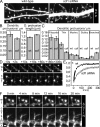Defining mechanisms of actin polymerization and depolymerization during dendritic spine morphogenesis
- PMID: 19380880
- PMCID: PMC2700375
- DOI: 10.1083/jcb.200809046
Defining mechanisms of actin polymerization and depolymerization during dendritic spine morphogenesis
Abstract
Dendritic spines are small protrusions along dendrites where the postsynaptic components of most excitatory synapses reside in the mature brain. Morphological changes in these actin-rich structures are associated with learning and memory formation. Despite the pivotal role of the actin cytoskeleton in spine morphogenesis, little is known about the mechanisms regulating actin filament polymerization and depolymerization in dendritic spines. We show that the filopodia-like precursors of dendritic spines elongate through actin polymerization at both the filopodia tip and root. The small GTPase Rif and its effector mDia2 formin play a central role in regulating actin dynamics during filopodia elongation. Actin filament nucleation through the Arp2/3 complex subsequently promotes spine head expansion, and ADF/cofilin-induced actin filament disassembly is required to maintain proper spine length and morphology. Finally, we show that perturbation of these key steps in actin dynamics results in altered synaptic transmission.
Figures








Similar articles
-
Molecular architecture of synaptic actin cytoskeleton in hippocampal neurons reveals a mechanism of dendritic spine morphogenesis.Mol Biol Cell. 2010 Jan 1;21(1):165-76. doi: 10.1091/mbc.e09-07-0596. Epub 2009 Nov 4. Mol Biol Cell. 2010. PMID: 19889835 Free PMC article.
-
Drebrin-dependent actin clustering in dendritic filopodia governs synaptic targeting of postsynaptic density-95 and dendritic spine morphogenesis.J Neurosci. 2003 Jul 23;23(16):6586-95. doi: 10.1523/JNEUROSCI.23-16-06586.2003. J Neurosci. 2003. PMID: 12878700 Free PMC article.
-
The Arp2/3 Complex Is Essential for Distinct Stages of Spine Synapse Maturation, Including Synapse Unsilencing.J Neurosci. 2016 Sep 14;36(37):9696-709. doi: 10.1523/JNEUROSCI.0876-16.2016. J Neurosci. 2016. PMID: 27629719 Free PMC article.
-
Role of actin cytoskeleton in dendritic spine morphogenesis.Neurochem Int. 2007 Jul-Sep;51(2-4):92-104. doi: 10.1016/j.neuint.2007.04.029. Epub 2007 May 13. Neurochem Int. 2007. PMID: 17590478 Review.
-
The structure and function of actin cytoskeleton in mature glutamatergic dendritic spines.Brain Res. 2014 Jul 21;1573:1-16. doi: 10.1016/j.brainres.2014.05.024. Epub 2014 May 20. Brain Res. 2014. PMID: 24854120 Review.
Cited by
-
The antagonistic modulation of Arp2/3 activity by N-WASP, WAVE2 and PICK1 defines dynamic changes in astrocyte morphology.J Cell Sci. 2013 Sep 1;126(Pt 17):3873-83. doi: 10.1242/jcs.125146. Epub 2013 Jul 10. J Cell Sci. 2013. PMID: 23843614 Free PMC article.
-
mDia1 and WAVE2 proteins interact directly with IRSp53 in filopodia and are involved in filopodium formation.J Biol Chem. 2012 Feb 10;287(7):4702-14. doi: 10.1074/jbc.M111.305102. Epub 2011 Dec 17. J Biol Chem. 2012. PMID: 22179776 Free PMC article.
-
p39 Is Responsible for Increasing Cdk5 Activity during Postnatal Neuron Differentiation and Governs Neuronal Network Formation and Epileptic Responses.J Neurosci. 2016 Nov 2;36(44):11283-11294. doi: 10.1523/JNEUROSCI.1155-16.2016. J Neurosci. 2016. PMID: 27807169 Free PMC article.
-
Nucleation geometry governs ordered actin networks structures.Nat Mater. 2010 Oct;9(10):827-32. doi: 10.1038/nmat2855. Epub 2010 Sep 19. Nat Mater. 2010. PMID: 20852617
-
The small GTPase Rif is an alternative trigger for the formation of actin stress fibers in epithelial cells.J Cell Sci. 2010 Apr 15;123(Pt 8):1247-52. doi: 10.1242/jcs.061754. Epub 2010 Mar 16. J Cell Sci. 2010. PMID: 20233848 Free PMC article.
References
-
- Bamburg J.R. 1999. Proteins of the ADF/cofilin family: essential regulators of actin dynamics.Annu. Rev. Cell Dev. Biol. 15:185–230 - PubMed
-
- Beli P., Mascheroni D., Xu D., Innocenti M. 2008. WAVE and Arp2/3 jointly inhibit filopodium formation by entering into a complex with mDia2.Nat. Cell Biol. 10:849–857 - PubMed
-
- Block J., Stradal T.E., Hänisch J., Geffers R., Köstler S.A., Urban E., Small J.V., Rottner K., Faix J. 2008. Filopodia formation induced by active mDia2/Drf3.J. Microsc. 231:506–517 - PubMed
Publication types
MeSH terms
Substances
LinkOut - more resources
Full Text Sources
Other Literature Sources
Research Materials

